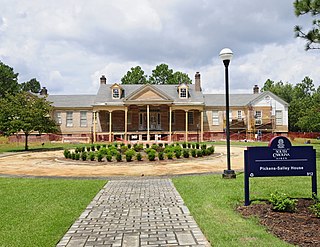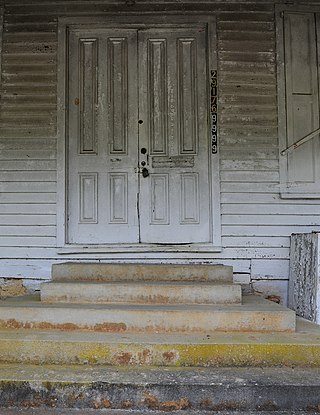
Edgefield is a town in Edgefield County, South Carolina, United States. The population was 4,750 at the 2010 census. It is the county seat of Edgefield County.

Trenton is a town in Edgefield County, South Carolina, United States. The population was 196 at the 2010 census, down from 226 in 2000.

Mill Hill is a historic neighborhood located within the city of Trenton in Mercer County, in the U.S. state of New Jersey. It is considered to be part of Downtown Trenton. The Mill Hill Historic District was added to the National Register of Historic Places in 1977.

Ashley River Historic District is a historic district located west of the Ashley in the South Carolina Lowcountry in Charleston, South Carolina, United States. The Historic District includes land from five municipalities, almost equally split between Charleston and Dorchester counties. The district includes dry land, swamps, and marshes of the Rantowles Creek and Stono Swamp watershed.

This is a list of the National Register of Historic Places listings in Edgefield County, South Carolina.

Horn Creek Baptist Church is a historic Baptist church in Edgefield, South Carolina. The congregation was founded in 1768 and the current building was constructed in 1790 and remains one of the oldest buildings in the county. The church was added to the National Register of Historic Places in 1971.

The Hatch Homestead and Mill Historic District encompasses two properties associated with the locally prominent Hatch family on Union Street in Marshfield, Massachusetts. It includes an early Georgian colonial house, and a 19th-century water-powered mill, both located on sites that had seen similar use since the 17th century. The district was listed on the National Register of Historic Places in 2009.

The Blocker House is a historic plantation house located near Edgefield, Edgefield County, South Carolina built circa 1790 by John Blocker, Sr. It is a two-story, clapboard dwelling with a one-story shed-roofed porch supported by four square columns. The property includes centuries old magnolia and cedar trees, a family cemetery, and several outbuildings.

The Pickens House, located in Aiken, South Carolina. It is reputed to have been built around 1829 by Governor Andrew Pickens for his son. In addition, the home is also noted for its early 19th century backcountry plantation architecture. Eventually the house was abandoned, and in 1929 it was moved from its original address near Edgefield to Aiken by a leading Aiken businesswoman and strong proponent of women's rights, Eulalie Chafee Salley. Around 1990 the home was again moved, this time to the campus of the University of South Carolina at Aiken. Much renovation work was taking place in the summer of 2012. The Pickens House was listed on the National Register of Historic Places on May 19, 1983.

The Copeland House is a vernacular farm residence built in the Carolina back country after 1790. It is located along what would in the early 19th century become an established coach road from the coastal counties to the interior. Constructed in the late 18th century by John Jacob Copeland (1775–1853), it became the center for his family that grew to include eight children. The house and the nearby farms, many belonging to families related by marriage over time, became significant contributors to a German Lutheran settlement in the area which took shape in this part of South Carolina a generation before the start of the American Revolution. The nearest town, Ehrhardt, South Carolina, is about 2 miles east of the Copeland House. The residence, initially built in the early 1790s, is significant for its association with the Copeland family, who built the house, occupied it continuously and farmed the surrounding property for nearly 200 years. In the mid-1980s the Copeland descendants, heirs to the fifth generation of the family, sold the property. The original square log and dovetail construction remains largely intact, even after several significant 19th and early 20th century modifications and additions were made. Subsequent owners have generally maintained the original fabric while stabilizing the structure. The house, together with several related dependencies and an adjacent Copeland family burial site, was listed in the National Register of Historic Places on October 18, 1991.

Darby Plantation plantation house was built by Nathaniel Lipscomb Griffith, the father of Anne Patience Griffith, at the time of her marriage to Edgefield lawyer Milledge Luke Bonham. It has a deep wraparound porch supported by twelve columns. The main rooms are twenty feet by twenty feet with twelve foot ceilings, and the house is built of pine. When Bonham returned from the United States' war with Mexico, he was elected to the U.S. House of Representatives. At the outbreak of the Civil War, Bonham was put in charge of South Carolina's volunteer army and served with distinction. In 1862, he resigned his commission and became governor of South Carolina. In 1863, the house was sold to Confederate Secretary of the Treasury George Trenholm. During the Civil War, the house was used as a storage place for some of the items from the Charleston Museum. Since 1878, the plantation has been owned by the Wise family.

Cedar Grove is a historic plantation house located near Edgefield, Edgefield County, South Carolina. It was built between 1790 and 1805, and is a large two-story, Federal style house with a white clapboard exterior and high gable roof. It features a double-tiered portico with delicate Adamesque detail. This home has many unusual architectural features including a barrel-vaulted hallway, elaborately carved mantelpieces, and the right front parlor retains an early hand-painted French wallpaper.

Bettis Academy and Junior College is a historic African-American Baptist school complex and national historic district located near Trenton, Edgefield County, South Carolina. Bettis Academy and Junior College was established in 1881 and closed in 1952. The complex now consists of three contributing buildings and one contributing site, all dating from the last 20 years of the institution. The remaining buildings are the rock-faced Alexander Bettis Community Library (1939); a bungalow-form building with a dual-pitched pyramidal roof; the stuccoed brick Classroom Building (1935); and the rock-faced Colonial Revival style Biddle Hall (1942).

Johnston Historic District is a national historic district in Johnston, Edgefield County, South Carolina. The district encompasses 127 contributing buildings, 16 contributing sites, 1 contributing structure, and 1 contributing object in the village of Johnston. The district includes commercial and residential properties from approximately 1880 to 1920. They are in a variety of popular architectural styles such as Italianate, Second Empire, Victorian, Queen Anne, and Neo-Classical. The district also includes three churches and the town's cemetery. The railroad, which passes through Johnston, was the primary cause for the creation of the town and continues to be a reminder of the town's early transportation history. Notable buildings include the Johnston Depot, Western Carolina Bank, H. W. Crouch Building, Bank of Johnston, Crouch-Halford House, and Johnston First Baptist Church.

Edgefield Historic District is a national historic district located at Edgefield, Edgefield County, South Carolina. The district encompasses 33 contributing buildings, 6 contributing sites, and 1 contributing object in the town of Edgefield. The buildings center on the landscaped village green, and includes forty 19th century buildings, three of which are house museums. There are a number of 19th century Greek Revival style homes, while others are noted for beautiful Federal style fanlights and unusual doorways. Other district properties include Victorian influenced homes and downtown commercial buildings. Five churches represent the Georgian, Victorian Gothic, and modified Gothic architectural styles. Notable buildings include the Edgefield County Courthouse, Trinity Episcopal Church and Rectory, St. Mary's Catholic Church, Halcyon Grove, Oakley Park, Carroll Hill, Blocker House, Yarborough House, and Padgett House.
Pottersville is a historic archaeological site located near Edgefield, Edgefield County, South Carolina. It was the site of the Pottersville kiln, which was in existence until the American Civil War when it was abandoned. The kiln was involved in the production and distribution of the alkaline glazed wares. The Pottersville kiln site is now a large mound in a grassy field atop a hill. An adjoining depression may have been the kiln itself with the waste dumps now the mound.

White Oak Historic District is a national historic district located near Winnsboro, Fairfield County, South Carolina. The district encompasses 12 contributing buildings in the rural community of White Oak. The buildings in the district were built between about 1876 and about 1925, and includes three large frame residences, a frame church with steeple, two frame store buildings, a cotton warehouse, and two vacant, wooded lots, some of which reflect Victorian stylistic influences. Notable buildings include the T. G. Patrick Store, McDowell's Store, White Oak Cotton Warehouse, Matthew Patrick House, T. G. Patrick House and outbuildings, and White Oak A.R.P. Church and Manse.

Claussen House, also known as the Howard-Harllee-Claussen House, is a historic plantation house located at Florence, Florence County, South Carolina. It was built about 1830, and is a raised cottage with early-19th century Greek Revival architecture and late-19th century Italianate style alterations and additions. Also on the property are a contributing smoke house, gardener's cottage, hothouse/greenhouse, chicken coop/outhouse, and carriage shed.

Tabernacle Cemetery is a historic cemetery located near Greenwood, Greenwood County, South Carolina. It was established in 1812, and includes the graves of many prominent citizens of Abbeville and Edgefield Districts and later Greenwood County as well, from the early-19th through the 20th centuries. It is the only cemetery in South Carolina where two Confederate Generals, namely brothers-in-law Nathan George Evans and Martin Witherspoon Gary, are buried. Most graves date from about 1812 to about 1950. The cemetery contains approximately 132 marked graves.
Trapp and Chandler Pottery Site (38GN169) is an historic archaeological site located near Kirksey, Greenwood County, South Carolina. It is the last known intact site of a production center of Edgefield decorated stoneware. The Trapp and Chandler Stoneware pottery was an antebellum pottery factory and began production of Alkaline glazed utilitarian stoneware around 1834. It continued production until the later part of the 19th century.






















